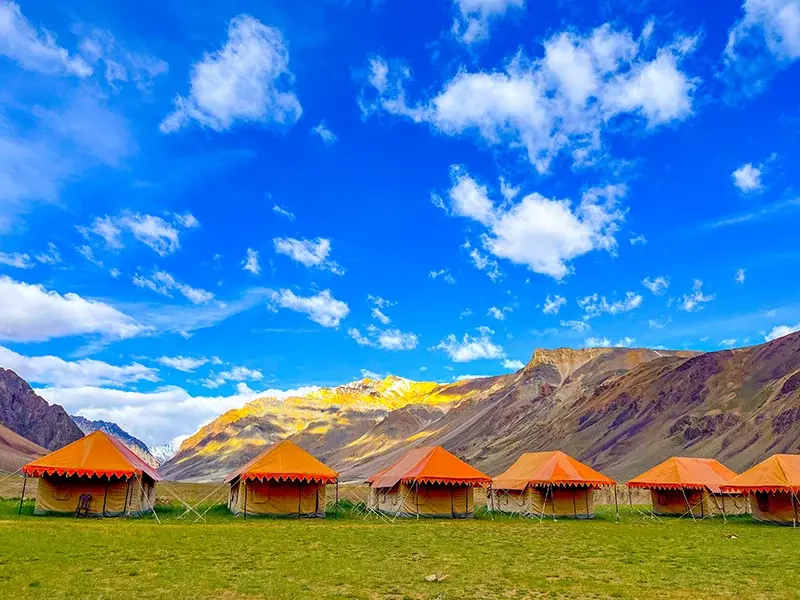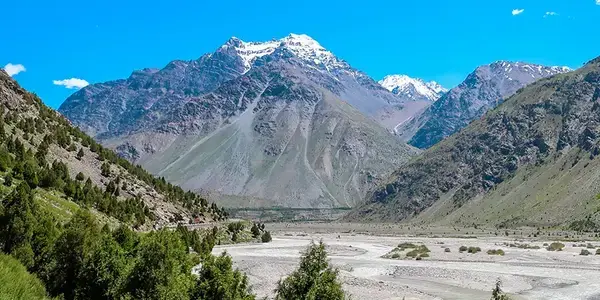


Sarchu, also called Sir Bhum Chun, lies right on the border between Himachal Pradesh and Ladakh. It sits at an altitude of about 14,070 ft and has been a key halt on the Leh–Manali highway for many decades. Historically, it served as a meeting ground for traders and nomads traveling between the Indus Valley and Spiti-Lahaul regions. Long before roads existed, caravans used to stop here for rest, thanks to the flat land and proximity to river water.
Though uninhabitable year-round due to extreme weather, Sarchu became popular in the late 20th century when the Leh–Manali road opened to adventure traveler ...

Places To Visit In Lahaul Valley
Top places to visit in Lahaul Valley.
.webp)
Images Of Lahaul Valley
Experience Lahaul’s raw landscapes, mountains and villages through images
Places To Visit In Lahaul Valley
Images Of Lahaul Valley
Insulated Jackets & Thermals
Even in June or July, Sarchu is freezing at night. Carry down jackets, thermals, and layers to stay warm in your tent.
Wool Caps, Gloves & Sunglasses
Windburn and sunburn are common. Protect your head, hands, and eyes, especially if you're outdoors during the day.
Acclimatize in Jispa/Keylong
Spend at least one night in Keylong or Jispa before staying at Sarchu. It gives your body time to adapt to thin air.
Essential Medicines
Keep AMS tablets, Diamox, paracetamol, and ORS handy. Inform your tent staff immediately if you feel dizzy or breathless.
Camp Under the Stars
The night sky here is magical—perfect for stargazing. Just zip open your tent and lie back under the Milky Way.
Watch the Sunrise Over Plains
Wake up early to witness golden light washing over the flatlands and hills. It’s quiet, surreal, and peaceful.
Photography & Landscape Shots
Bring your camera! The dramatic cliffs, barren landscapes, and cloud shadows create postcard-worthy frames all day long.
Dal Rice & Maggi at Dhabas
Local food joints serve dal-rice, Maggi, omelettes, and chai. It's simple but comforting in the cold mountain weather.
Carry Energy Bars
Backup snacks like protein bars, dry fruits, and instant soup are useful since food availability is basic and limited.
June to September is perfect for tent stays and clear views.
Sarchu, also called Sir Bhum Chun, lies right on the border between Himachal Pradesh and Ladakh. It sits at an altitude of about 14,070 ft and has been a key halt on the Leh–Manali highway for many decades. Historically, it served as a meeting ground for traders and nomads traveling between the Indus Valley and Spiti-Lahaul regions. Long before roads existed, caravans used to stop here for rest, thanks to the flat land and proximity to river water.
Though uninhabitable year-round due to extreme weather, Sarchu became popular in the late 20th century when the Leh–Manali road opened to adventure travelers and bikers. Today, it’s a temporary camping ground offering Swiss tents, basic dhabas, and jaw-dropping landscapes. With snow-capped mountains and the Tsarap River running nearby, it is now one of the most iconic overnight stops en route to Ladakh. The Indian Army also maintains camps and checks at Sarchu, given its sensitive border location and extreme altitude.
Gateway Between Himachal and Ladakh
Sarchu is the official entry and exit point between the two states, marked by a check post and altitude warning boards.
Altitude of 14,070 Feet
Oxygen levels are low, and travelers often experience mild symptoms of AMS. Proper acclimatization before reaching is crucial.
Tented Accommodation Only
You won’t find hotels or homestays—only Swiss tents and dhabas operate here from June to September.
Tsarap River Flows Nearby
This river adds beauty to the campsite and serves as a water source for many temporary establishments.
Army Presence Year-Round
Indian Army camps are set up nearby for security and support, especially for stranded travelers during road closures.
The Lost Trekker’s Tale
In 2008, a solo backpacker on a cycling expedition from Manali to Leh stopped at Sarchu for a night. He wandered off for a short evening walk but got lost due to sudden fog and declining light. With temperatures dropping rapidly and no mobile signals, he was stranded for nearly 12 hours before an army search patrol found him the next morning. His story became popular in travel forums and taught many future travelers a lesson in high-altitude safety, terrain awareness, and the importance of not exploring alone after sundown in Sarchu.
Tents That Survive the Wind
Locals often share how tents in Sarchu are specially made to survive fierce winds. One such incident happened when a violent storm hit unexpectedly in July 2017. Most of the tents flapped wildly, but a few high-quality setups stood firm—earning the nickname “bulletproof tents.” The incident sparked interest in better tent construction and safety for high-altitude camping zones, eventually improving the tourism setup in Sarchu.
A valley is a low-lying area between hills or mountains, often formed by the erosion of water or glaciers. Valleys are characterized by their U-shaped or V-shaped profiles and can contain rivers, streams, and fertile land.